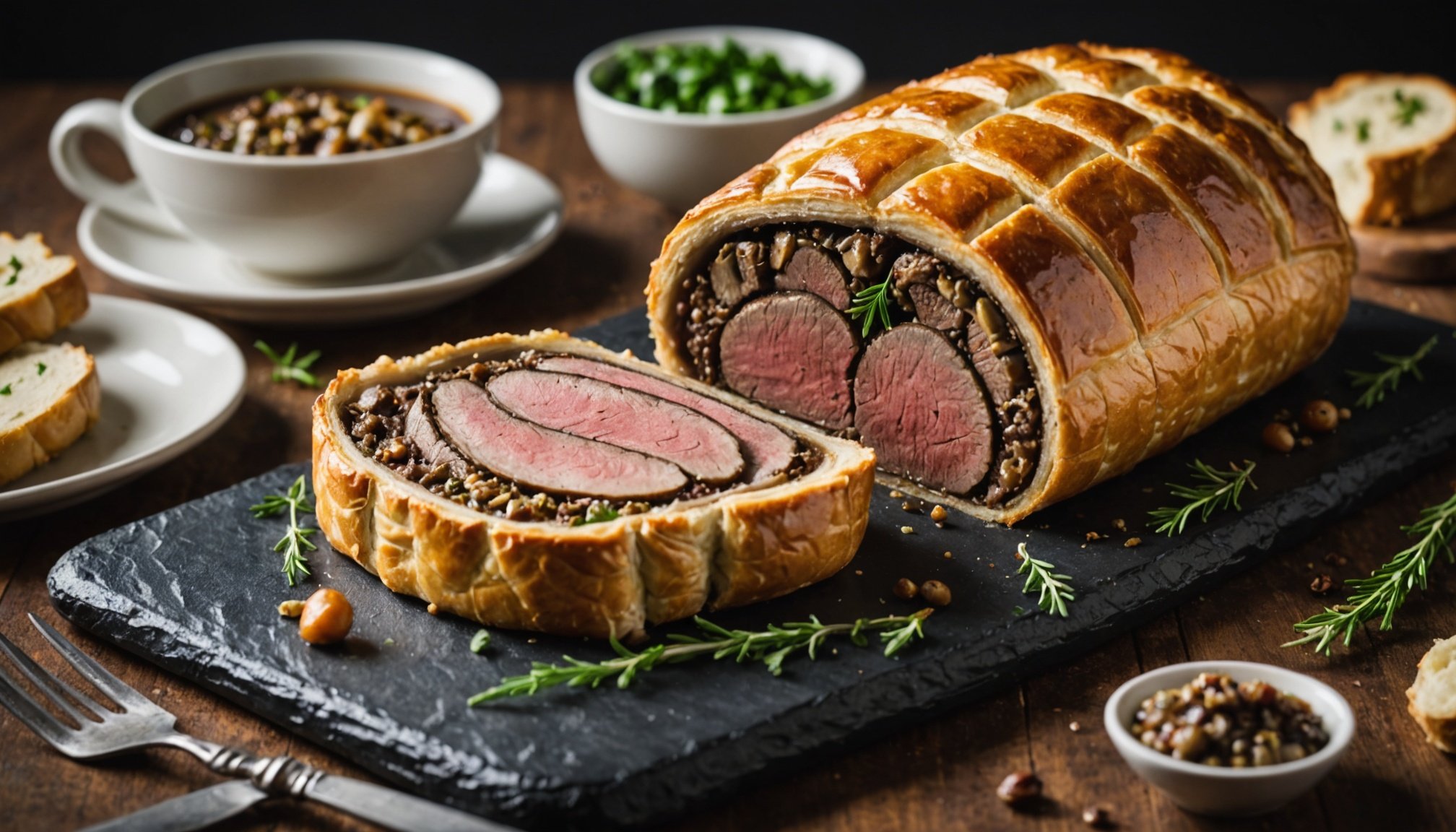Understanding Beef Wellington
Beef Wellington is a classic dish that combines various elements to create a culinary masterpiece. At its core, the dish comprises a tender beef fillet, wrapped in a layer of mushroom duxelles and pâté, encased within a golden, flaky pastry. Originating from the sumptuous kitchens of 19th-century Europe, its name traditionally honours the Duke of Wellington, though the exact links are debated among historians.
The key components—beef, duxelles, pâté, and pastry—each play pivotal roles. The beef serves as the centerpiece, providing richness and depth. The mushroom duxelles, a finely minced sautéed mushroom mixture, adds an earthy umami flavour, complementing the beef’s intensity. Pâté, often foie gras, lends a luxurious texture and flavour, while the pastry encasing offers a satisfying crunch.
Also to read : Mastering the Art of Swiss Chocolate Fondue: Essential Techniques for a Sumptuously Smooth Treat
The importance of quality ingredients cannot be overstated. Choosing the best cuts of beef, such as the tenderloin, ensures succulent tenderness. Fresh mushrooms are crucial for an aromatic, flavourful duxelles, and high-quality pastry provides a crisp, golden shell. Together, these elements balance one another aesthetically and culinarily, creating the sophisticated delight known as Beef Wellington.
Selecting Ingredients
Selecting the right ingredients is crucial for a mouth-watering Beef Wellington. The choice of beef cut significantly impacts the final outcome. For an exceptional dish, the tenderloin is highly recommended owing to its tenderness and compact shape. This cut ensures a succulent and flavorful centerpiece.
This might interest you : Unlock the Secret to Perfecting Slow-Cooked British Beef Stew Packed with Nutritious Root Vegetables!
The mushroom duxelles requires fresh mushrooms to build its distinctive, earthy flavor profile. Opt for varieties such as button or cremini mushrooms, which balance flavor and moisture. Sautéing these mushrooms until all moisture evaporates allows a concentrated taste, crucial in complementing the beef.
For a perfect Wellington, several other essential ingredients are involved. High-quality pâté, often made from foie gras or chicken liver, contributes a rich layer of flavor. The pastry, preferably puff pastry, should be buttery yet light, creating a crispy golden shell.
Alternatives exist for these components: you may substitute the tenderloin with ribeye for a slightly different texture, or replace pâté with a vegetarian pate if desired. Mushrooms can also be swapped for caramelized onions if mushrooms aren’t palatable.
Choosing top-notch ingredients carefully, thus, is key to crafting a Beef Wellington that truly delights and satisfies, maintaining the renowned culinary elegance of this dish.
Preparing Mushroom Duxelles
Mushroom duxelles are crucial to a successful Beef Wellington, enhancing its flavour and providing a textural contrast.
Duxelles Preparation Steps
The preparation begins by finely mincing mushrooms, which can include varieties such as button or cremini. This step is vital for achieving the concentrated umami flavour duxelles is known for. Once minced, sautéing involves cooking the mushrooms over medium heat until their moisture evaporates, leaving a concentrated, flavourful mix. This reduction process is essential to ensure the duxelles do not make the pastry soggy during cooking.
Flavor Enhancements
Enhance these mushroom duxelles with herbs and seasonings. Introducing fresh thyme or parsley, along with a pinch of salt and pepper, can elevate the mixture’s profile. A dash of white wine during the sautéing process might add depth.
Storage and Usage
Once prepared, duxelles can be stored in an airtight container in the refrigerator for up to a week. Ensure cooled completely before sealing to maintain freshness. This storage capability allows for preparation well in advance, reducing the workload during the assembly phase. Using duxelles beyond Beef Wellington application, consider as a topping for toast or a filling for omelettes, making them a versatile kitchen staple.
Assembling the Wellington
Creating a perfectly assembled Beef Wellington involves strategic layering to achieve a harmony of flavours and textures. Start by ensuring that the beef, duxelles, and pastry components are ready for construction. Each element should be prepped and properly chilled to maintain structural integrity during assembly.
Layering Components
Begin with a generous spread of mushroom duxelles on a flat surface, topped with a layer of pâté if using one. Place the seasoned beef fillet at the centre and carefully wrap it within the duxelles and pâté combination. Once enveloped, lay the wrapped beef on the pastry sheet. Roll the pastry tightly, ensuring all edges are sealed to prevent leakage.
Preventing Sogginess
To combat sogginess, consider using a crepe or thin egg omelette between the pastry and duxelles. This extra layer acts as a barrier, absorbing excess moisture and safeguarding the pastry’s crispiness.
Achieving a Professional Finish
For a professional touch, use an egg wash over the pastry for a golden finish. Cut small slits on top to allow steam to escape, preventing uneven cooking. Finally, be mindful of chilling time; sufficiently chilled Wellington slices cleanly and retains its defined layers when baked.
Cooking Techniques and Methods
Crafting the perfect Beef Wellington requires understanding the right cooking techniques. Mastering the oven temperature and cooking time is essential for achieving ideal doneness.
Ideal Cooking Styles
Roasting is the preferred method, focusing on even heat distribution around the pastry. For culinary enthusiasts seeking adventure, sous vide cooking ensures precise temperature control before finishing it in the oven to achieve the golden and crispy pastry exterior.
Internal Temperature Guide
Internal temperature determines the beef’s doneness. Aim for:
- 55°C (131°F) for medium-rare,
- 60°C (140°F) for medium,
- and 65°C (149°F) for medium-well.
Using a meat thermometer, check these temperatures to maintain a succulent centerpiece.
Oven Setup
Preheat your oven to 200°C (392°F). Ensure convection settings are off, which can dry out the pastry. Place the Beef Wellington on a preheated baking sheet to help the pastry crisp evenly along the bottom. To avoid premature browning, consider an aluminum foil tent over the top for the initial baking phase.
Successfully implementing these techniques results in an exquisite Beef Wellington, showcasing a perfect balance of flavors and textures.
Serving Suggestions
Pairing Beef Wellington with the right side dishes and accompaniments elevates the dining experience, complementing its rich flavours. Traditional side options include duchess potatoes and glazed carrots, which provide subtle sweetness and a starchy texture that balances the dish. For a lighter approach, consider serving a crisp arugula salad with a lemon vinaigrette, adding a refreshing contrast to the pastry’s richness.
Plating Techniques
Presentation is key to showcasing Beef Wellington’s elegance. Slice the Wellington cleanly to reveal its layers, arranging it on warmed plates for visual appeal. A drizzle of red wine reduction over the meat enhances the presentation and flavour, offering a touch of sophistication. Garnishing with fresh herbs or microgreens can add visual vibrancy and a mild flavour without overpowering the main dish.
Wine Pairing Recommendations
Wine pairings can further enhance the dining experience. A classic choice is a full-bodied red wine, such as a Bordeaux or a Pinot Noir, which complements the beef’s intensity and the pastry’s buttery notes. For those seeking a more adventurous pairing, a robust Syrah might provide a delightful contrast, elevating the complete meal into a memorable culinary event.
Common Pitfalls and Troubleshooting
Crafting a perfect Beef Wellington can sometimes present challenges. Identifying common cooking mistakes is vital to achieving success.
Common Mistakes to Avoid
One frequent issue is overcooking the beef, resulting in a dry centerpiece. It’s essential to monitor the internal temperature, as discussed previously. Another mistake is using too much pastry, leading to a thick, undercooked outer layer. Opt for a thin, even pastry to ensure proper baking.
Troubleshooting Tips
To address a soggy pastry, ensure your mushroom duxelles are sufficiently reduced. Excess moisture can interfere with the pastry’s crispness. If your pastry tears during wrapping, patching with spare pastry helps maintain the appearance. Always seal edges tightly to prevent filling leakage.
Expert Advice
Pro tips from chefs often include pre-chilling components before assembly, which maintains the structure during baking. Using a crepe layer between duxelles and pastry can further prevent moisture issues. Additionally, letting the Wellington rest briefly after baking allows juices to redistribute, improving overall texture.
By understanding these pitfalls and employing solutions, you can elevate your Beef Wellington from a daunting challenge to a culinary triumph, ensuring each preparation step contributes to its celebrated taste and presentation.
Variations of Beef Wellington
Beef Wellington is a dish with an illustrious past, but it also offers room for modern creativity. Exploring new variations can transform this classic into a contemporary masterpiece.
Gourmet Versions
Adventurous cooks are creating novel gourmet versions of Beef Wellington by adjusting common components. These can include substituting different proteins like salmon or lamb, each bringing its own unique flavour profile. The rich taste of lamb pairs exceptionally well with mint-infused mushroom duxelles, offering a delectable twist on the traditional recipe.
Alternative Fillings
For those seeking alternative fillings, consider incorporating sautéed spinach or sun-dried tomatoes within the pastry. These not only provide a pop of colour but also create flavorful contrasts while preserving the dish’s essence. Additionally, swapping pâté with blue cheese or a mild goat cheese can introduce a new depth of flavour to the Wellington.
Adapting for Dietary Preferences
The adaptability of Beef Wellington means it can cater to various dietary needs. Vegetarians might appreciate a version featuring roasted vegetables or plant-based proteins as the centrepiece. Using gluten-free pastry dough allows for those adhering to such dietary restrictions to enjoy this iconic dish without compromise.
These recipe adaptations allow both novice cooks and seasoned chefs to expand their culinary repertoire while retaining Beef Wellington’s timeless elegance.









